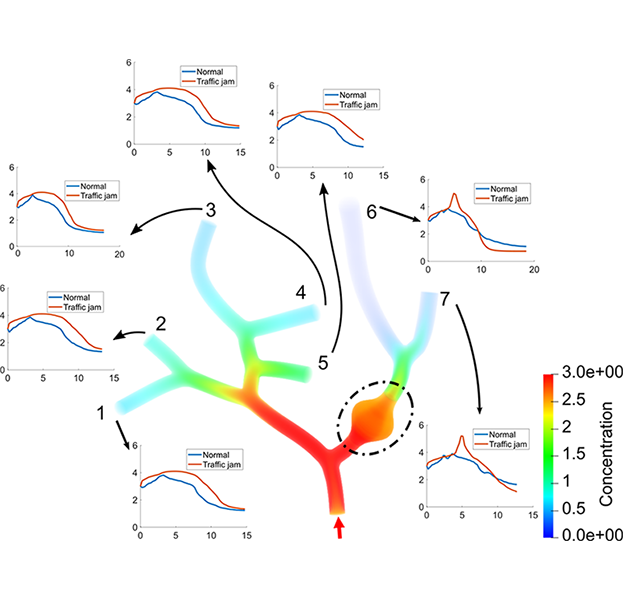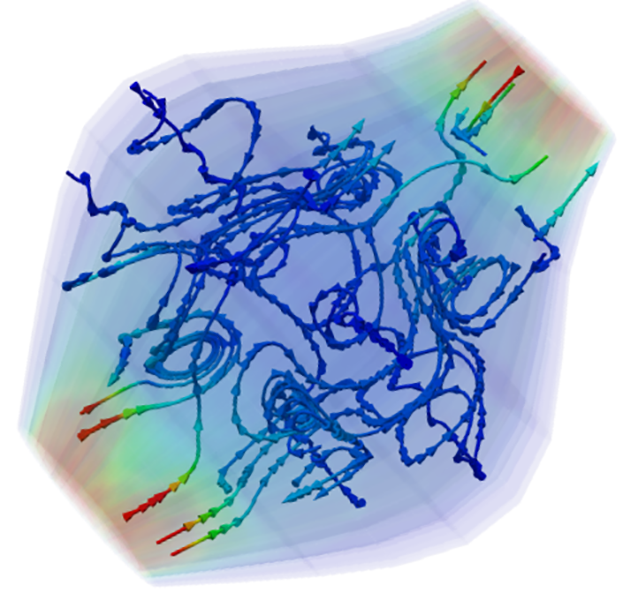Modeling neuron traffic jams in the brain
MechE’s Jessica Zhang and Angran Li have developed a new way to model material transport regulation in neurons using cutting-edge parametrization technology and isogeometric analysis.
Jessica Zhang and Angran Li have developed a new way to model material transport regulation in neurons, focusing on the “traffic jams” that occur in these neural pathways. These traffic jams play a role in diseases such as Alzheimer’s, Huntington’s, and Parkinson’s disease. The team is using a new modeling technology called isogeometric analysis (IGA) to model neurons and these traffic jams more accurately.
Neural traffic jams occur along the microtubules in the axon, reducing the healthy flow of neural materials to different parts of the neuron, and over time will starve the ends of the neurons causing neural degeneration. These traffic jams can lead to the neurons secreting Tau proteins, an early predictor of Alzheimer’s disease.
Zhang, a professor of mechanical engineering, and Li, a Ph.D. student, modeled these microtubules and the two main ways these traffic jams occur using partial differential equation (PDE) constrained optimization, a novel approach pioneered in this research. The neurons modeled came from neuromorpho.org, a database of digitally-reconstructed models of real neurons.
One way these neural traffic jams occur is by a reduction of microtubules in a region, which impacts the volume of neurons that are able to move along the axon or dendrites. The second way is by axon swelling and microtubule swirling, which increases the distance the materials have to travel. In addition, as they spread out to take up space, their delicate balance can go awry, creating accumulated masses of materials in the swollen pathways. This makes it extremely difficult for neural materials to move properly through the pathways.
Using an IGA-based, PDE-constrained approach to modeling 2D and 3D complex structures produces smooth and accurate models when compared to traditional finite element analysis (FEA). FEA models objects by breaking them down into extremely small elements, such as cubes or triangles. IGA models objects using “splines,” which model the boundaries of these objects in smooth surfaces instead of very small piece-wise linear elements like FEA. IGA is also computationally less costly and can be optimized far more easily than FEA due to having fewer degrees of freedom.
Zhang’s team has pioneered volumetric spline parameterization and the use of IGA in a variety of applications. Her team has worked with the simulation program LS-Dyna (which was acquired by ANSYS and used by Honda). Honda found that IGA outperforms traditional FEA when modeling fracture simulations in cars. Having used IGA to model other parts of the body, such as veins and the heart, their research team plans to continue the medical applications of this modeling method.
As reported in their earlier work, modeling these microtubule transport systems in 2D using IGA took eight to 12 hours using multiple cores on an XSEDE supercomputer from the Pittsburgh Supercomputer Center. That laid the groundwork for modeling these neurons in 3-D, which took six CPU nodes from six to 28 hours to complete.


